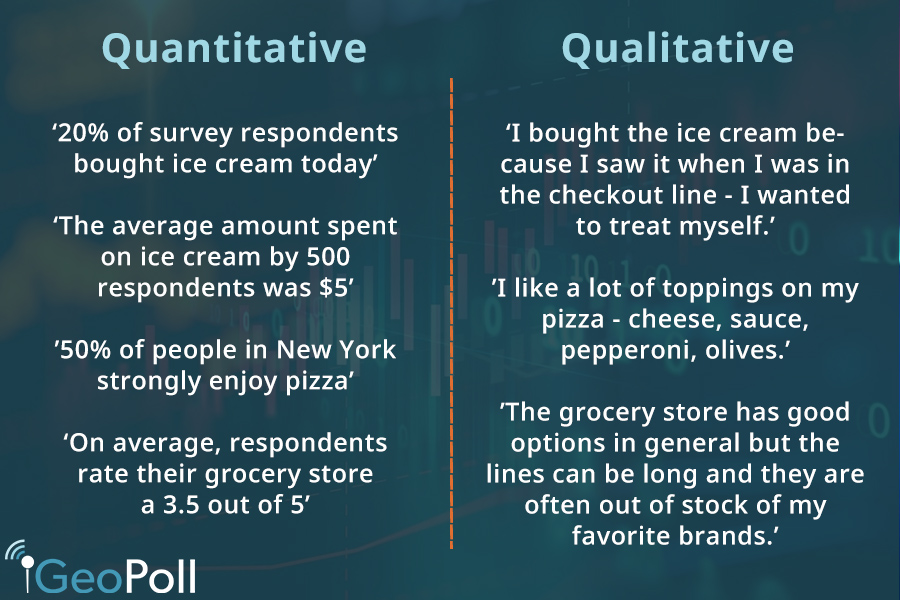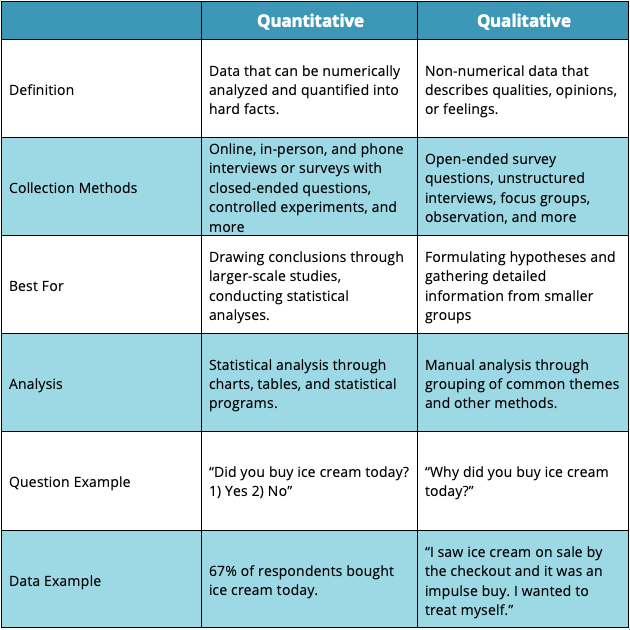- Contents
Quantitative and qualitative research methods differ in several ways, including how quantitative and qualitative data is collected and analyzed and the type of insights that each method can provide. While researchers can combine quantitative and qualitative methods to more fully answer their research questions, each has unique characteristics that should be considered throughout the lifecycle of a research project. Jump to GeoPoll’s cheat sheet on qualitative vs quantitative research.
Difference Between Quantitative and Qualitative Data
The primary difference between quantitative and qualitative data is that quantitative data represents data that can easily be measured or quantified, such as the number of people who have bought a product. Qualitative data represent opinions or feelings and cannot be represented by a numerical statistic such as an average.
For example, if a survey asked 500 respondents the question “Did you buy ice cream today?”, and 300 responded ‘yes’ while 200 responded ‘no’, we would know that 300/500 or 60% bought milk, a quantitative fact. If the same survey asked an open-ended follow-up question: “Why did you choose the brand of ice cream you bought?” you would receive qualitative insights that are unique to each respondent. One person may say, ‘I liked the packaging and label colors’ while another may state, ‘It was the first one I saw on the shelf.’ These descriptive insights cannot easily be quantified into numbers, so they are qualitative.
Qualitative vs Quantitative Analysis
Another difference between quantitative and qualitative research is how data is analyzed. While quantitative data can be analyzed statistically and calculated into averages, means, and other numerical data points, qualitative data analysis involves a more complex system.
To glean insights from qualitative data, researchers conduct a manual analysis of datasets and often code responses into categories. For example, to analyze focus group data, researchers could review transcripts or recordings and group similar sentiments together into categories. Due to this manual process, qualitative data analysis is a longer and more labor-intensive process than quantitative data analysis, which is another factor to keep in mind when deciding what type of data to collect.
While some methods such as focus groups typically collect qualitative data, other methods such as surveys often collect quantitative and qualitative data within one survey instrument, as outlined below.
Quantitative Data Examples
Quantitative data is collected through several methods, including surveys, controlled experiments, and certain observation types. Quantitative data types include:
- Yes/no questions
- “Did you go to work today? 1) Yes 2) No”
- Single choice questions
- “What is your favorite flavor of ice cream? 1) Vanilla 2) Chocolate 3) Cookie Dough 4) Peppermint 5) Chocolate chip”
- Multiple choice or ‘select-all-that-apply’ questions
- “Which of the following products did you buy last week? 1) Toothpaste 2) Soap 3) Vegetables 4) Meat 5) Grains 6) Bread”
- Ranking questions
- “Please rank the statement ‘I enjoy ice cream’ from 1: Strongly disagree to 5: Strongly agree”
- Numerical range questions
- “How much money did you spend at the grocery store today? Please respond with a dollar amount”
- Quantitative observations
- Observations that can be categorized or quantified, such as the number of times a person checks their phone in a given time. These observations often take place in a controlled environment.
As all of these question types collect data that fit into set categories or can be calculated into averages and other statistics, they are quantitative.
Qualitative Data Examples
Qualitative data can also be collected through certain types of survey questions, in addition to interviews and focus groups. Examples of qualitative data include:
- Open-ended survey questions
- “Why is cookie dough your favorite flavor of ice cream?”
- Unstructured or semi-structured interviews
- Unstructured and semi-structured interviews allow topics and questions to flow naturally, rather than only asking questions from a set question list in a specific order.
- Focus groups
- In focus groups, multiple people have a discussion (in-person or via an online or mobile-based chat group) facilitated by a trained moderator who gives prompts to start conversations.
- Unstructured observation
- Researchers can gather qualitative data through unstructured observations, such as observing participants as they partake in certain activities such as shopping.
- Documents or content analysis
- Reviewing documents to better understand a particular topic or categorize elements of documents is a type of qualitative research.
Data collected from these methods and question types do not provide numerical statistics but instead, give insights that are often longer and more detailed than their quantitative counterparts.
When Should I Use Quantitative or Qualitative Research?
 Once you understand the types of data provided by qualitative and quantitative research and the methods for each, it’s essential to understand how to utilize each type of data best. Generally, quantitative data is used to answer precise questions and prove or disprove hypotheses, while qualitative data provides richer insights on a smaller scale.
Once you understand the types of data provided by qualitative and quantitative research and the methods for each, it’s essential to understand how to utilize each type of data best. Generally, quantitative data is used to answer precise questions and prove or disprove hypotheses, while qualitative data provides richer insights on a smaller scale.
Qualitative research is often conducted at the beginning of a study when researchers are looking to gather broad, unstructured information on a topic to create a hypothesis, which can then be more clearly answered by quantitative research. Qualitative data collected through unstructured interviews or focus groups can also inform the development of a more structured questionnaire administered to a larger group.
For example, a focus on different ice cream brands may uncover that participants generally consider price and packaging first. That information can then be inputted into a quantitative question: “Which is more important to you when buying ice cream? 1) Price 2) Packaging” administered to a nationally representative sample.
Qualitative data may also be used as part of a mixed-methods research study to add additional context to quantitative data. A researcher may administer both a quantitative questionnaire and conduct a qualitative analysis of interviews with subject-matter experts to form a more robust conclusion.
Surveys can also be split between qualitative and quantitative; Many surveys are mostly quantitative questions that can be quickly analyzed, plus one or two qualitative questions that provide deeper insights into the topic being studied.
Quantitative vs Qualitative Data: Definitions and Uses Cheat Sheet

GeoPoll has experience designing and administering both quantitative and qualitative research studies around the globe. Our research methods include surveys with closed-ended and open-ended question capabilities, mobile-based focus groups, concept testing, and more. To learn more about GeoPoll’s capabilities, please contact us today.
